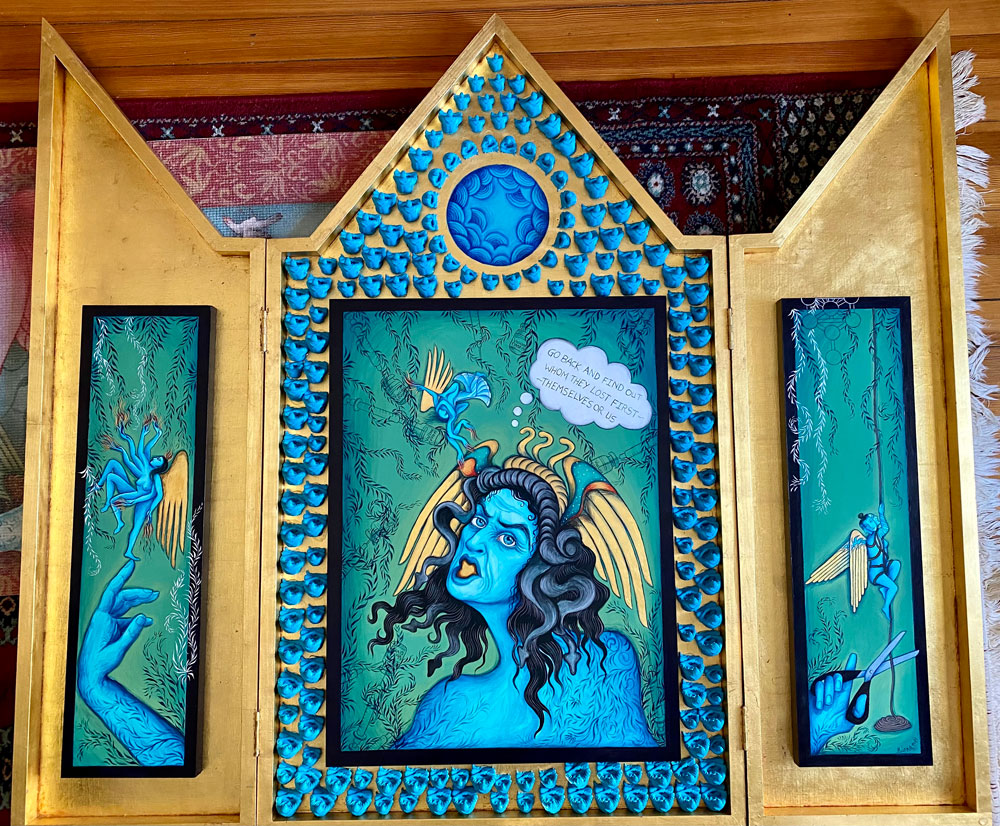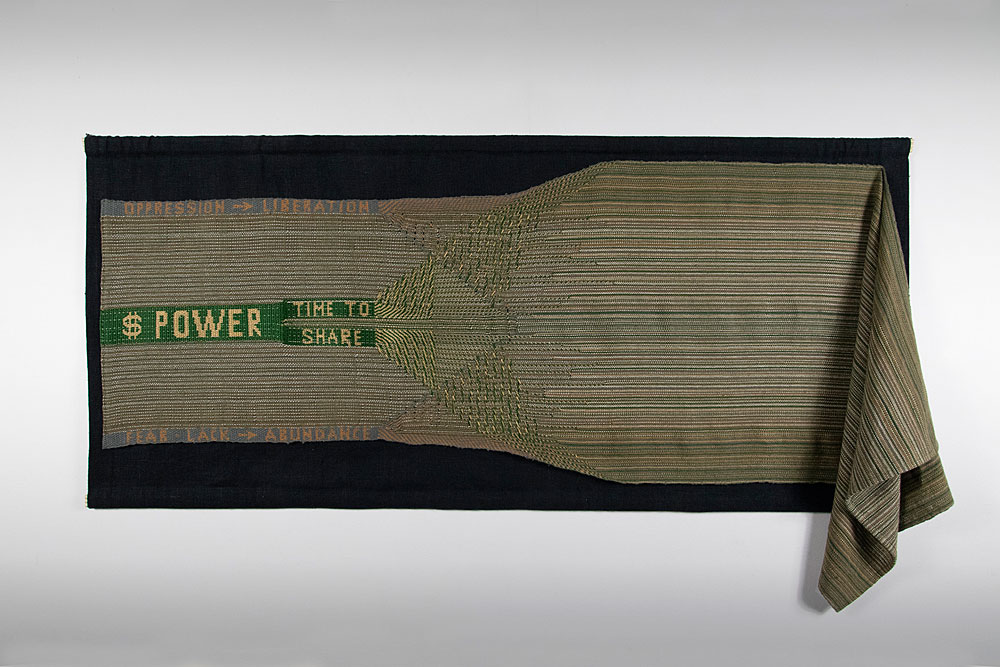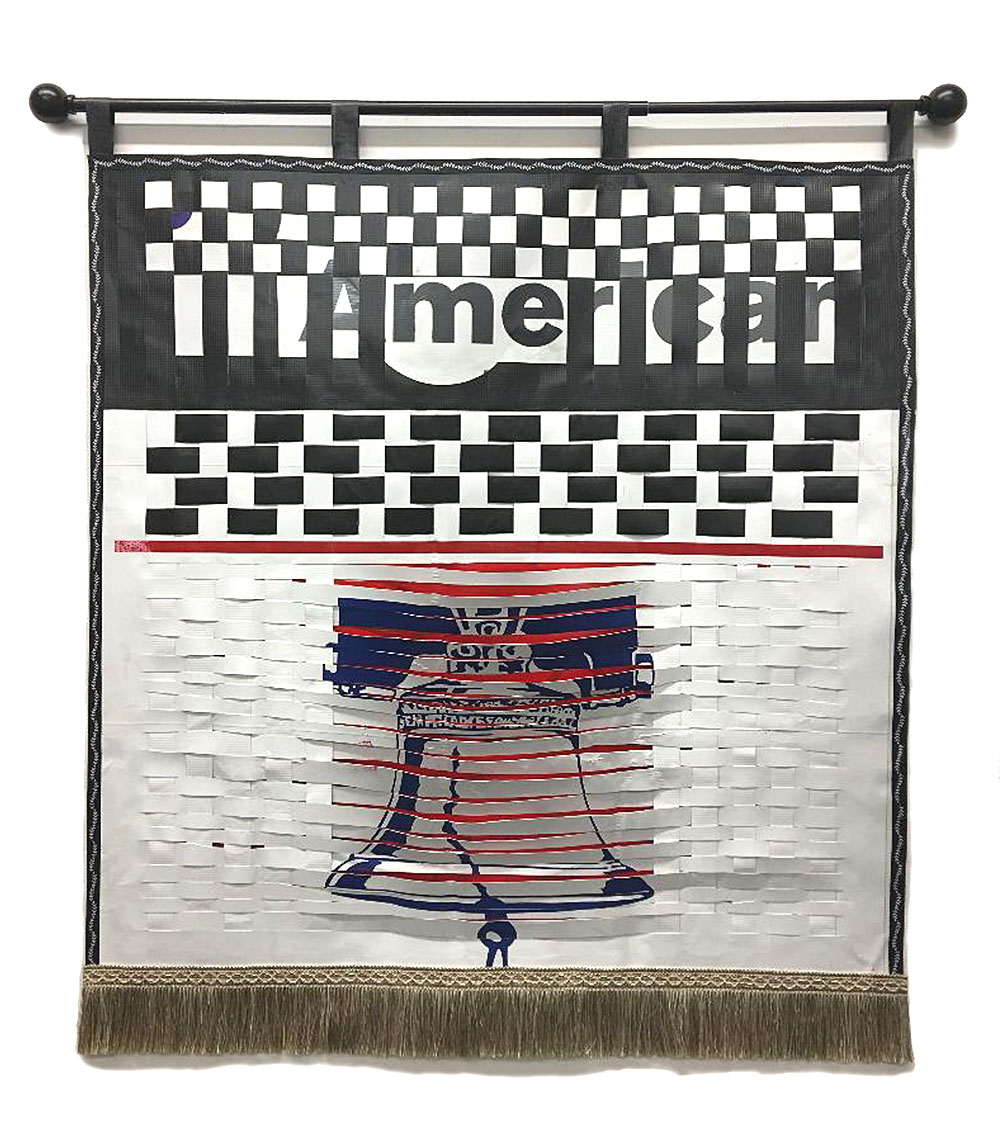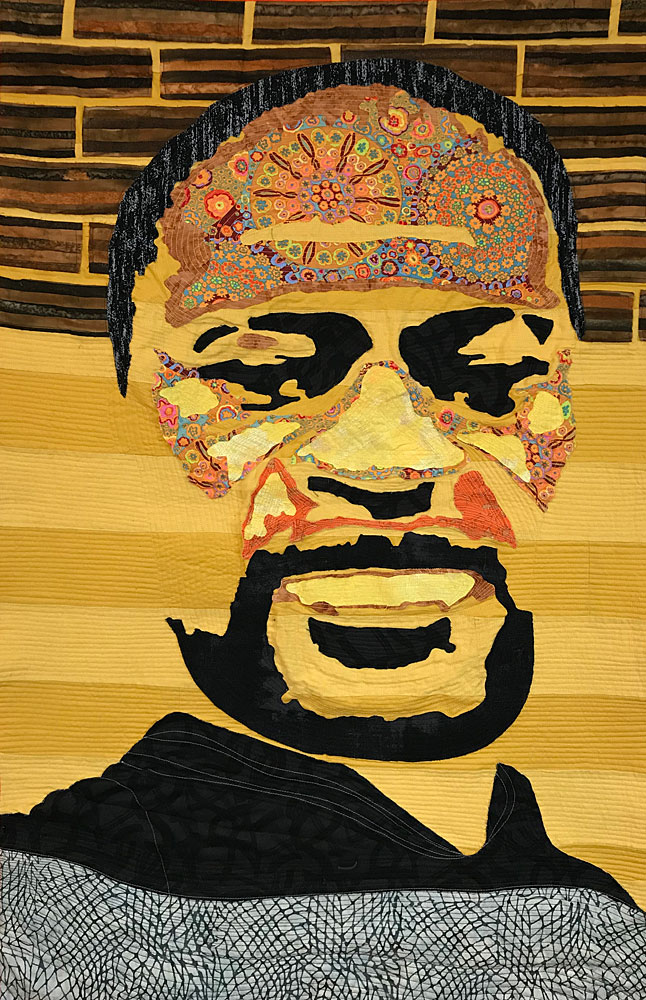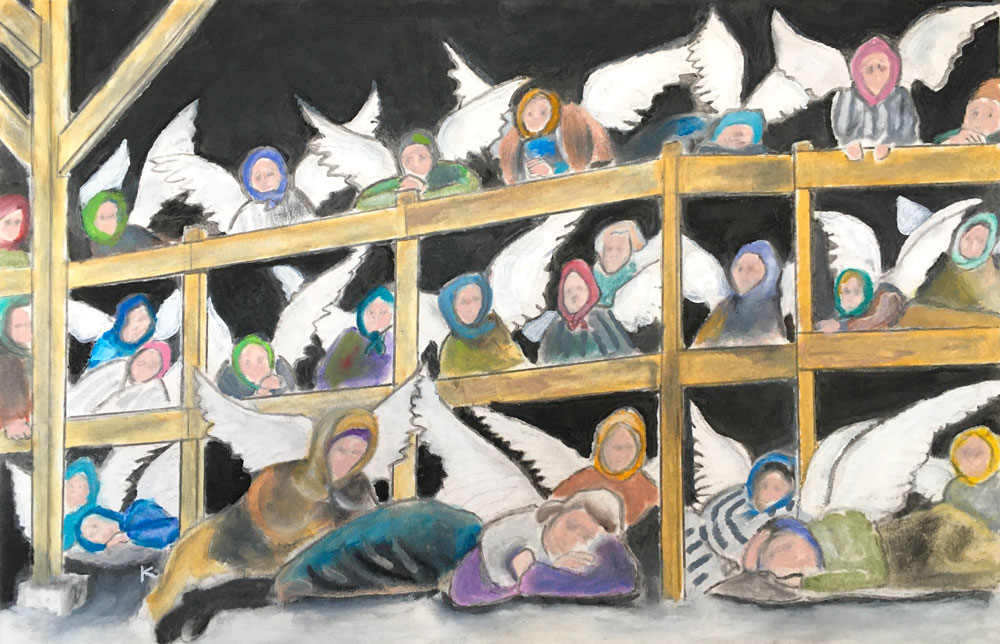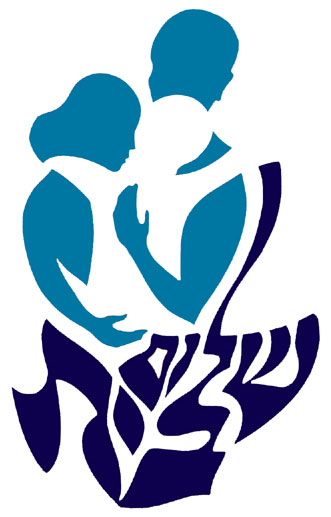Karen Walanka, z”l (1946-2018)
Karen was a long-time member of the AGJA and the Guild’s president in 2015. In 2007, Karen founded the Judaic Arts Fair in Chicago, one of the most highly regarded biennials of Jewish art and culture in the United States, sponsored by Moriah Congregation. The AGJA’s annual Karen Walanka Online exhibit is a way for us to honor Karen’s memory, her love of beauty and her life-long ambition to bring it to us all.

Curatorial Statement
Dictionary definitions tell us that responsibility is the state of having a duty to deal with something or someone, being required to render account and be answerable. Power is fundamentally the ability to control events and other people.
An overarching theme of today’s discourse is social justice, accompanied by the underlying bass line that social injustice is the norm. Class, race, religion, ethnicity, sexuality, gender are all markers: categories that segregate people for better or worse circumstances. Is there a moral imperative that should guide the exercise of power and responsibility toward the elimination of systemic inequality?
For this exhibit we asked artists to explore responsibility and power in the realm of social justice as conjugations of each other. As each begets the other, moral metrics guide their exercise. Our participating artists have translated our topic from its abstract verbalization to visual representation with extraordinary vision and creativity. We are so honored to be able to present this work to you; visit, revisit, contemplate, absorb, share, and enjoy this event.
Beth Goldstein and Robin Atlas, Co-Curators
Beth Goldstein
Beth Goldstein has been associated with the American Guild of Judaic Art for many years – as an exhibiting member, sponsor, and curator. “When I married my work in fine art and design with my Judaism, it absolutely rewired my entire mindset of both my artwork and my faith.”
From her studio in her hometown of Cincinnati, Ohio, Beth creates and produces Judaica and Jewish themed works of art that can be found in synagogues, galleries, and private collections.
Beth’s approach to Judaic art is far from niche. She has infused everything from fine art to coloring books, from Ketubot to dreidels, with her spirited sense of the role Judaism plays in daily life. Five new Torah Mantles Beth was recently commissioned to design have been heralded for their innovative, liturgical interpretation of the four seasons, exhibiting her technical finesse in gouache painting and her intuitive sense of purpose. This is just one of many examples of Beth’s delicately determined Judaic artwork.
In “The Art of the Hebrew Alef Beit;” a big book of 26 monoprints, Beth united truth with the fine art of Jewish storytelling. As a curator, Beth initiated and brought to her community the first Exhibit and Celebration of National Jewish Arts Month, an event promoted annually by the AGJA. The exhibit, “About Faith;” featured, promoted, and gave voice to female Jewish artists from the greater Cincinnati area. It was hugely successful and became the forerunner of many future faith-based events in and around Cincinnati, a city already rich in Jewish heritage, history, and community.
Robin Atlas
Robin Atlas is a visual artist, printmaker, fine arts consultant, and curator whose work has been exhibited throughout the United States. She creates contemporary visual midrash – the process of artistic personification of Hebrew biblical and other sacred Jewish texts as well as halachic laws, adding her own creative voice and vision to the ever-evolving anthology of commentary.
Her mixed media pieces combine dyed, manipulated, and collaged fabric and other fibrous materials which have then been deconstructed and embellished with hand and machine embroidery, paper, paint, beadwork, trim, and other elements.
She is president of the American Guild of Judaic Art and a co-founder of Vector Artist Initiative.
WALANKA 2021
Zvi Suchet
The Rabbi of Port Louis, 2019
Photography/Digital Illustration
Size: 28″ x 39″
Edition: 18
In this piece I introduce what has become a regular element in my work which is the figure of the “Lone Jew”. The Lone Jew represents the predicament of Jewish identity. With his back to the viewer, the figure’s personal features are hidden, he is identified and judged on his label as a “Jew”. Looking out onto the world, he is faced with the responsibility of how to conduct himself in the world. His task is to relay the power and wisdom of his centuries-old heritage while positively representing his identity. www.zvisuchet.com
Siona Benjamin
AMISTAD: A Slave Ship for a New Century, 2021
Mixed Media and 22K Gold Leaf on Wood Panel
43” x 48”
Based on the concept of Eugenics, I was inspired to make a boat-like triptych. I combined that shape with the idea of the slave ship, carrying numerous refugees hopefully into safety and asylum from their countries and dictators of persecution. Blue seated men sit packed in the golden boat, scared yet hopeful – hopeful not to be sent back to their destruction. Lilith who is also that pestering angry woman. Is this the moral and human condition of our era? www.artsiona.com
Exodus: I See Myself in You, 2016
Gouache, Gold Leaf on Wood Panel
3.5″ x 10″
Based on the inspiration of exploring Paradise or (Pardes in Hebrew and Jannat in Urdu/Arabic), this work questions what is the pursuit of Paradise. Recent history and news has made me question why we all as human beings strive for perfection and paradise. At what cost do we want to attain it and why do we seek that ultimate perfect home. Looking at the thousands of images that flood the news today of people who are displaced from their homes, these refugees roaming the world are in the constant search for their lost paradise, or their quest for a new one. What would paradise be like if we ever manage to reach it? Is paradise really flawed and yet it has immense value? Is this value needed to help us keep hope in life? www.artsiona.com
Shoshannah Brombacher
The Trial of the Shpoler Zeida, 2016
Oil on Canvas
24” x 18”
Sometimes it’s necessary to use one’s power and responsibility in ways unthinkable under normal circumstances. The community of the Chassidic Rebbe, scholar, and judge known as the Shpoler Zeida (the “Grandfather of Shpola” in Ukraine, d.1811) suffered perpetual abuse from the government, antisemitism, pogroms, discrimination, and deep poverty. But when, additionally, a famine threatened their existence, the Zeida didn’t summon the government to court but G’d Himself, whom he held responsible for the fate of His Jewish children. No other rabbi then had the will, the power, or the audacity to do so. The Zeida “ordered” G’d with “holy rage” to care for the Jews and the famine ended. www.absolutearts.com/portfolios/s/shoshannah
The Holy Rage of the Shpoler Zeida, 2020
Oil on Canvas
24” x 18”
The Awe of the Shpoler Zeida, 2020
Oil on Canvas
36″ x 36″
Lois Gaylord
The Restructuring, 2020
Fiber: Weaving (Loom and Tablet) 21” x 46” (Plus Overhanging Draped Fabric on Right ~ 6-7”)
The idea behind this piece is to find a way to restructure the fabric of society while maintaining the parts that do work. Wealth and power are concentrated in the hands of the few. Too many people, especially those of color and folks who don’t fit the dominant culture’s norms, are marginalized. The cloth begins as a sparse background with 3 tablet woven bands representing the current systemic inequality of society. The warp threads from the 3 bands are gradually redistributed throughout the weaving, transitioning from a sleazy (loosely woven) cloth to an integrated, sturdy fabric. www.loisgaylord.com
Shelley Heffler
Power and Responsibility
American Liberty
Repurposed Billboard Vinyl
42”x 36”
The liberty bell torn and shredded. The word American is behind shredded vinyl signifying bars. This piece was a response to all the children who came over the border and have been locked down in cages. The ME in American is exposed and questions the idea of American identity and people who want to be Americans. www.shelleyheffler.com
Nothing is Sacred
Repurposed Billboard Vinyl
42” x 33”
The foreground is an image of an interior cathedral which forms a shredded pocket that hides and reveals hands in the background. The hands can be seen as going into a pocket or coming out of a pocket. www.shelleyheffler.com
Migrant American
Repurposed Billboard Vinyl
58” x 45”
Dorothea Lange’s photo of “Migrant Mother” – her iconic dustbowl photo of a migrant woman and her children are woven with brightly colored geometric shapes. Migrants have been the backbone of our country; picking up work to make ends meet, usually picking vegetables, fruit and labor that pays little. They are hidden from our everyday life, subservient to the needs of the urban cities. The juxtaposition of the two cultures clashing and intermingling on this canvas shows how we are interwoven together literally and figuratively. www.shelleyheffler.com
Gilah Yelin Hirsch
Time and Consequence, 2017
Acrylic on Canvas
60″ x 120″
Every action triggers consequence. Before making any decision, the far-seeing enlightened individual will exercise their power of choice while considering the best of all possible repercussions for the greater good before any step is taken. It is in the history of humanity that we recognize the ultimate consequences of the power and responsibility of choice. www.gilah.com
Untie/Unite, 2019
Acrylic on Canvas
72″ x 120″
Inherent in any choice is inevitable consequence. One may assume responsibility to seize power while thinking that one is uniting disparate elements. Actually in the farther vision by granting freedom to the various parties, one can achieve unity and build a healthy society through social volition. www.gilah.com
Crucible, 2017
Acrylic on Canvas
60″ x 30″
The gestation of every human is a crucible of the past, the present, and the future. The potential of all this information is limitless. While the power of possibility is represented both as flames and encrypted letters, the outcome remains mysterious and unpredictable. Once this is recognized, the power of responsibility falls upon the individual. www.gilah.com
Matt Lome
Jerusalem’s Never-Ending Story, 2018
Oil on Canvas
48″ x 60″
In no place on earth is the struggle for power and control more magnified than in Jerusalem, Israel. Throughout its long history, the holy city has been destroyed, captured, recaptured and attacked more times than this artist can count.
The theme of this year’s exhibition – the relationship between responsibility and power – is greatly depicted in my painting. Amidst a panorama of conflict and struggle for power, a rabbi is hugging his beloved Torah. The Torah is open, demonstrating the wisdom of its stories; the wisdom of the highest authority of all.
The idea behind my painting is that governance, in the absence of fundamental values, (i.e., values that are taught in Judeo/Christian literature) is always doomed to failure. Holy scripture warns us that power is extremely corrosive, most especially, where there is a lack of moral responsibility.
According to holy scripture, the abuse of power is virtually always due to an egregious lack of humility under G-d. Those who abuse power always demonstrate intolerance, discompassion, elitism and bigotry. Throughout all of history, the irresponsible wielding of power – power asserted in the absence of tolerance and compassion – has been the catalyst to every political collapse that ever was. www.mattlome.com
Carol Neiger
Defiant Requiem
Monoprint
24” x 30”
“I got the requiem as a present to take with me all my life”. Unknown survivor. The ability of one man to lead so many souls to the spirit of creativity is proof that we all have the ability to make this world a better place, even if that better place is only for a short time. www.carolneiger.com
Libera Me
Oil on Canvas
30” x 40”
I am interested in the complexity of the survival of the Jewish people. I was inspired by the thought that the inmates of Terezin, being robbed of so much, experienced synesthesia, allowing them to feel warmth and colors, and to feel lighter–which gave them hope.
This piece was created as a response to learning about conductor Rafael Schächter who founded the Prague Chamber Opera in 1937 and was arrested and deported to Terezin in 1941. He led tens of thousands of others who were imprisoned in Terezin Concentration Camp in organized musical performances initially to raise spirits and morale after finding a piano deserted in one of the work camp buildings, and later through the Verdi Requiem as acts of defiance. His power through music raised up optimism, and courage and continues to teach us about what people can do under extraordinary circumstances. Inspired by the thought that the inmates of Terezin being robbed of so much, experienced synesthesia—allowing them to feel warmth and colors through communal music which gave them hope. I created works inspired by the creative power of music from observation that the human spirit can illuminate the best in humanity and overcome the worst. Ancient Greek philosophers conflated “Beauty” with “Goodness” in the concept of kallos; perhaps for these imprisoned artists, the beauty they found in art was the only goodness left in a hostile universe. Rafael Schächter was transported in 1944 to Auschwitz. He died in 1945 while on a death march, one month before Czechoslovakia was liberated. Schächter was only 39. www.carolneiger.com
Ellen November
Lafayette Park, 2020
Fabric, Thread and Edited Images Printed on Fabric
39″ x 19″
This piece depicts an aerial view of Lafayette Park showing BLACK LIVES MATTER painted in yellow on the adjoining street. Superimposed on the image are faces of African Americans who were murdered by police. Most noticeable are George Floyd and Breonna Taylor. The killing of these individuals has highlighted the injustices people of color in the United States have suffered. www.ellennovember.com
George Floyd RIP, 2020
Fabric and Thread
44″ x 27″
The murder and subsequent tributes and funerals of George Floyd had me riveted to media. I still cannot watch the entire nine minutes of his murder at the hands of a police officer. His cries for his Mother have gripped me. I feel the deep pain of the injustices of the murders of people of color at the hands of law enforcement. www.ellennovember.com
Rhoda Ryba
Do Not Remain Silent, 2018
Mixed Media Collage
19” x 16”
Perhaps the most classic TaNaKh exemplification of the power of responsibility and the responsibility of power, is the story of Queen Esther. This painting illustrates the urging by Mordechai that the young queen has a responsibility to speak up on behalf of her People, because she is in a position of power, and may have obtained that position of power “for just such a time as this.” I painted this inspired by the “Me Too” women’s movement. www.batyaryba.com
Open Your Hand, 2021
Watercolor
20” x 16”
This is an abstract painting depicting an individual with his/her head above the clouds, and his/her hand in the pocket. The text from Proverbs 3:27, 28 embedded in this painting would say to me that when our own responsible life management has generated the power of success and well-being, we must not delay giving of those resources — take the hand out of the pocket and open it to those in need. www.batyaryba.com
Eddy Shuldman
“DO NOT STAND IDLY BY…..” Afroamerikaner Blut iz Nisht Keyn Vasser African American Blood is not Water
Fused Glass
20.5” x 12.375”
The power of words: leading to action or inaction. Inspired by how to say “Black Lives Matter” in Yiddish, I selected Afroamerikaner Blut iz Nisht Keyn Vasser. By depicting the chalked outline of a body on a sidewalk, I wanted to communicate the anonymity of those who have died on our streets by violence, specifically out of hatred, racism, and ignorance. Stare at the outline and tell me about that body that bled out on concrete pavement. Male? Female? Black? White? Straight? Homosexual? Jew? Muslim? Christian? Atheist? Leviticus teaches us…”Do Not Stand Idly By While Your Neighbor’s Blood Is Shed!” sparksofspirit@gmail.com
Debbie Teicholz Guedalia
Portrait of a Lost Generation, Girl, 2019
Portrait of a Lost Generation, Boy, 2019
Photo Collage created from a portfolio of black and white, silver gelatin photographs, taken in a Jewish cemetery in Paris c. 1982. The photographs are ripped, burned, and collaged and then mounted on stretched canvas supported by oval wooden frames.
26” x 21”; 26” x 21”
These “Portraits of a Lost Generation” represent children killed in the Holocaust, and the relationships that history severed.
In 2020, a nationwide survey of people under 40 reported that 63% were unclear or unknowledgeable about the basic facts of the Holocaust. It is our responsibility to teach it and then transfer its lessons to combat prejudice and persecution. www.debbieteicholzguedaliaphotography.com
Portrait of Rabbi Andrea Weiss, 2021
Photo Collage. Color portrait of Rabbi Weiss with added Hebrew text and collaged photographs taken of her garden and of the Torah Ark at Hebrew Union College.
30” x 20”
Rabbi Andrea Weiss is the first female Rabbi Provost of Hebrew Union College. This personal portrait represents her power and spiritual responsibility: standing in her garden she wears text (Deuteronomy), textiles and light refractions from the HUC Torah Ark; the dew, God’s presence, and her fig tree, (Micah) ground her. www.debbieteicholzguedaliaphotography.com
Rachel Braun
God Covers the Sky with Clouds, 2016
Psalm 147
Blackwork Embroidery; Cotton Floss on Aida Cloth
5.5” x 14.5”
Psalm 147 provides numerous images of God’s power. God rebuilds Jerusalem, gathers the exiles, heals broken hearts, binds up wounds, names the stars, gives courage to the lowly, and brings down the wicked. Power is expressed through God’s responsibility to the needy on earth.
God’s manifest power over nature is also a topic of the Psalm. These attributes are represented in verses 8, 16, and 17, embroidered into the artwork: “God covers the sky with clouds, and prepares rain for the Earth, bestows snow as a blanket of wool, and hurls hail like breadcrumbs.”
“Who can withstand God’s cold?” the Psalm continues. God’s power in nature is at once compassionate and threatening.
Today, humans have taken on increasing power over nature, but in contrast to the words of the Psalm, do not underscore their actions with attention to the needy.
When is the cold precipitation a peaceful, sensory treat, and when is it a threat? How can we withstand God’s cold? The Psalm gives guidance to us in humanity’s ongoing conquest of nature. The exercise of power is safe when it is framed by responsibility to the migrant, the broken-hearted, the wounded, the dreamy stargazer, the lowly, and the righteous. www.rachelbraun.net
Barbara Barron
Kristallnacht, 2017
Fiber and Machine Applique Embroidery
32” x 18”
Kristallnacht is perhaps the first public event to mark the Nazi campaign against European Jews. Nearly a century later, we remember not only the destruction of that night and its victims, but we think on our responsibility in this present moment, with the fragile state of human rights throughout the world. As artists we have the power to connect the past, present and future through imagery. www.barronjudaicart.com
Valeriya Khomar
Familia is an expression of the essence of interconnectedness, my interpretation of life and our being. Treating another person as a member of your family with full respect – is the only power to which we are entitled and must use. www.artistvaleriyakhomar.com
Michael Bogdanow
Don’t Be Afraid, 2016
Acrylic on Canvas
30” x 15”
Don’t Be Afraid was inspired by the words of the wonderful religious thinker and Chasidic leader, Rabbi Nachman of Bratslov (1772-1811), the great-grandson of the Baal Shem Tov (the founder of Hasidism). As for this year’s theme, one thing seems certain: for power and responsibility to be used to help us create a more socially just world, we cannot let fear stop us, as “all the world is a very narrow bridge, and the essence is, don’t be afraid.” www.michaelbogdanow.com
Aaron Koster
Oh Lord Where Were You, 2020
Pencil and Pastel on Paper
11” x 17”
Was g-d responsible for preventing the Holocaust? I’m in my 80th year still having the need to ask: Respectfully, Dear Lord, where were you? www.1-aaron-koster.pixels.com
Avy Ashery
Shalom Bayit/Family Love, 2019
Serigraph
26” x 20” reprint color change
Shalom Bayit/Family Love is a basic Jewish, yet universal value that goes back to ancient biblical Torah times. The idea is that in any given family unit it is expected that each member be respectful, kind, and loving to all family members at all times. www.asheryartprograms.com
Roslyne Smith
Rina, 2020
Acrylic on Canvas
30” x 30”
It is the mitzvah of lighting Shabbat candles that rekindles the divine spark in every Jewish being. Today all of us have an even greater responsibility to dispel the darkness. Candle lighting time is auspicious for private prayer. While your eyes are covered this is the time to take a moment and pray for whatever your heart desires. Through my paintings, I offer the viewer a reminder to take the time to stop, breathe and connect. This is a time to pray for health, peace, well-being, and redemption that the whole world knows there is only one G-d. My use of bright colors reflects joy and beauty. Through my paintings, I hope to spread the light of Shabbat. www.roslynesmith.com


